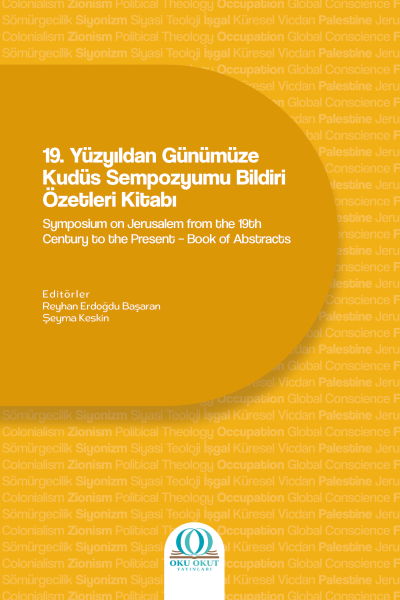Oku Okut Yayınları, kitabın yayım ve dağıtım hakkını saklı tutar. Ticari kullanım için yayınevine başvurulması gerekir.
سكان مدينة القدس في أواخر العهد العثماني وفق دفتر النفوس العثماني ( 1917-1864)م
The Population of Jerusalem in the Late Ottoman Period According to the Ottoman Population Register (1864–1917)
Yazarlar
-
Dr. Marwan Aqraباحث في مركز سيلون للبحوث والدراسات نابلس – فلسطين
شهدت مدينة القدس الشريف في أواخر العهد العثماني تطورا كبيرا في مختلف نواحي الحياة (الاجتماعية والاقتصادية والعمرانية) وهذا ما ساهم الى زيادة ملحوظة في عدد السكان الذين تضاعف أعدادهم لأسباب كثيرة من أهمها: توفر الرعاية الصحية والقضاء على الأمراض والاوبئة وانتشار الأمن والأمان في المدينة وقدوم عدد كبير من الناس للسكن في المدينة من مناطق أخرى داخل متصرفية القدس الشريف وبعض الولايات العثمانية الأخرى.
كان هناك اهتمام كبير بالمدينة من مختلف الدول الأوروبية التي حاولت أن تجد لها موطئ قدم داخل المدينة لأسباب دينية تتعلق في السيطرة على الأماكن الدينية المسيحية وخصوصا كنيسة القيامة، فكان هناك انشاء مدارس جديدة تتبع مختلف الطوائف وكنائس مسيحية وابنية وفنادق تتبع تلك الدول وقنصليات، وبسبب هذا الاهتمام الخارجي تنبهت الدولة العثمانية الى خطورة ما يجري وعملت على تطوير متصرفية القدس الشريف من جميع النواحي الإدارية والتعليمية والصحية حيث أسست بلدية القدس في عام 1869م لتكون ثالني بلدية في الدولة العثمانية بعد إسطنبول وبنت عدد من المدارس الحكومية لمختلف الأعمار وبنت المشفى الحكومي و منتزه البلدية ومهدت الطرق بين المدينة ويافا التي كانت بوابة للحجاج والزوار الأجانب.
عملت الحركة الصهيونية على انشاء عدد من المستعمرات الصهيونية في متصرفية القدس الشريف وحثت يهود العالم على الهجرة اليها لتغير ديمغرافية السكان في مدينة القدس وبسبب اعتراض أهالي المدينة على الهجرة اليهودية فرضت الدولة العثمانية قيودا على الهجرة اليهودية ومنعت بيع الأراضي لليهود وأصدر السلطان العثماني عبد الحميد الثاني فرمان بمنع بيع الأراضي لليهود في عام 1881م.
تهدف هذه الدراسة الى الاطلاع على أعداد السكان في مدينة القدس الشريف في أواخر الدولة العثمانية وتوزيعهم حسب الأديان والطوائف وبيان مكان سكناهم في حارات مدينة القدس الشريف التي كانت موجودة في أواخر العهد العثماني من عام 1874م الى 1917م داخل سور المدينة والأحياء الجديدة التي أسست خارج السور ومقارنة الأعداد في دفتر النفوس العثماني مع غيرها من الاحصائيات التي صدرت عن بعض المستشرقين وبعض القنصليات الأجنبية.
ومن أجل الإحاطة بهذا الموضوع سوف استخدم: دفتر النفوس العثماني الذي جاء وفق الإحصاء العثماني الذي قامت به الدولة العثمانية في مختلف ولاياتها وشمل جميع السكان وذكر أسمائهم وأسماء ابائهم وتاريخ ميلادهم وقرابتهم .
وكذلك الأرشيف العثماني في أنقرة وإسطنبول والأرشيف العثماني المحلي وسجلات المحكمة الشرعية والكتب والدراسات التي تناولت الموضوع.
In the late Ottoman period, the Holy City of Jerusalem witnessed significant development in various aspects of life, including social, economic, and urban growth. This progress contributed to a noticeable increase in the city’s population, which doubled for several reasons. Among the most important factors were improved healthcare, the eradication of diseases and epidemics, enhanced security and stability, and the arrival of a large number of people from different regions within the Jerusalem Sanjak and other Ottoman provinces. There was great interest in the city from various European countries, which sought to establish a presence in Jerusalem for religious reasons, particularly to control Christian holy sites, such as the Church of the Holy Sepulchre. As a result, new schools affiliated with different denominations were established, along with Christian churches, buildings, hotels, and consulates representing these countries. This external interest alerted the Ottoman state to the risks involved, prompting it to develop the Jerusalem Sanjak in all administrative, educational, and healthcare aspects. In 1869, the Ottoman authorities established the Jerusalem Municipality, making it the second municipality in the empire after Istanbul. They also built several public schools for different age groups, a government hospital, a municipal park, and paved roads connecting the city to Jaffa, which served as a gateway for pilgrims and foreign visitors. The Zionist movement sought to establish Jewish colonies within the Jerusalem Sanjak and encouraged Jewish migration to the city to alter its demographic composition. Due to strong opposition from the city’s residents, the Ottoman Empire imposed restrictions on Jewish immigration and prohibited the sale of land to Jews. In 1881, Sultan Abdul Hamid II issued a decree banning land sales to Jewish settlers. This study aims to examine the population of Jerusalem in the late Ottoman period, analyzing their distribution by religion and sect, as well as identifying their places of residence within the neighborhoods of Jerusalem. The study focuses on the period from 1874 to 1917, covering both the areas within the city’s walls and the newly established neighborhoods outside the walls. Additionally, it compares the population records in the Ottoman Population Register with other statistical sources, including reports from Orientalists and foreign consulates. To comprehensively address this topic, the study relies on the Ottoman Population Register, which was compiled as part of a general census conducted by the Ottoman authorities across their provinces. This register documented all residents, recording their names, their fathers’ names, birth dates, and family relationships. Additional sources include the Ottoman archives in Ankara and Istanbul, local Ottoman archives, Sharia court records, and various books and studies on the subject
Telif Hakkı
Telif Hakkı (c) 2025 Oku Okut Yayınları
Lisans

Bu çalışma Creative Commons Attribution-NonCommercial 4.0 International License ile lisanslanmıştır.
İndir
Yayın Bilgisi
-
Yayın TürüBölüm
-
Cilt
-
Sayfalar54-57
-
Yayım Tarihi11 Mayıs 2025
-
Dizi
-
Dizi No.12
-
Kategori
Aqra, Marwan. “سكان مدينة القدس في أواخر العهد العثماني وفق دفتر النفوس العثماني ( 1917-1864)م”. 19. Yüzyıldan Günümüze Kudüs Sempozyumu: Bildiri Özetleri Kitabı. ed. Reyhan Erdoğdu Başaran - Şeyma Keskin - critical ed . 12/54-57. Sosyal Bilimler Bildirileri. Ankara: Oku Okut Yayınları, 2025. https://doi.org/10.55709/okuokutyayinlari.412












